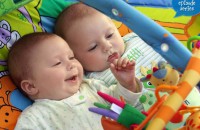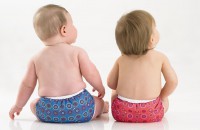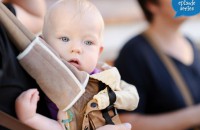Twin Talks
Developmental Twin Milestones: Movement/Physical Activity
Please be advised, this transcription was performed from a company independent of New Mommy Media, LLC. As such, translation was required which may alter the accuracy of the transcription.
[Theme Music]
WENDI MCKENNA: How do you know if your infant twins are on track for their physical development? If they were born prematurely, how does it affect their developmental timeline? And how can you help them develop their skills? I’m Wendi McKenna, doctor of physical therapy and founder of Move Play Grow. I’m here to talk about twin developmental milestones: movement and physical activity. This is Twin Talks.
[Theme Music/Intro]
CHRISTINE STEWART-FITZGERALD: Welcome to Twin talks, broadcasting from the birth education center of San Diego. Twin Talks is your weekly online on the go support group for expecting and new parents of twins. I’m your host Christine Stewart-Fitzgerald. Have you heard about the Twin Talks club?
Our members get bonus content after each new show, plus special giveaways and discounts. Subscribe to our monthly Twin Talks newsletter and learn about the latest episodes available. Another way for you to stay connected is by downloading our free Twin Talks app available in the Android and iTunes marketplace.
Before we get started, let’s introduce our panellist in the room. I’ve got twin girls who are now five as of last week. They’re identical and just started kindergarten which is a big thing. And then I also have a singleton who will be two next month and if I can say, as we were just talking earlier our expert here Wendi, our youngest have the same birth day. Very same birthdays.
SUNNY GAULT: yeah, awesome
WENDI MCKENNA: It’s always fun.
CHRISTINE STEWART-FITZGERALD: Yeah. And Sunny
SUNNY GAULT: Alright, so I’m Sunny and I’m the owner of New Mommy Media which produces Twin Talks as well as parent savers, the boob group and preggie pals. I have four children. I have a four year old, and two year old boy, uh boys, I guess I should say. And then my girls are identical twins and they are about ten months old. And this is really relevant to us because they are just now starting to really move and shake and you know they’re crawling and we are on the verge of walking, so, this is all good for me.
WENDI MCKENNA: It’s always fun.
SHELLY STEELY: I’m Shelly; I’m the producer here at Twin Talks. I have identical twin boys who just turned two in July. And then I have a singleton girl who’s just three weeks. She’s the one you heard a few minutes ago. Before we get started I wanted to let you guys know about our virtual panellist program. So you can follow us on Facebook or Twitter at home. But if you want to become a part of the conversation, you can use the #twintalksvp to answer and ask questions on your own.
[Theme Music]
SHELLY STEELY: Before we get started with today’s show, we’re looking to the headlines for news about twins. A recent article published in www.slate.com, talks about why identical twins aren’t really identical? So, as I’m sure all moms have identical twins can attest you’re kids are very different. In fact, and it turns out there might be a scientific reason for that.
So, biologists are realizing that idea of nature versus nurture is missing the importance of noise. And that’s not the noise coming from your toddlers. It’s the noise coming from your biological environment. So, it seems that even identical twins brought up in similar environments aren’t really identical. They don’t have the same fingerprints, they have different freckles and moles. And then intelligence and even mental illness can vary between identical twins.
So there are new researches pointing out to tiny differences in their developmental environments. So that’s position in the uterus, all the way up to pre-school teachers to Junior prom dates according to the article. In addition there’s this third factor that biologists overlooked into the past few decades and that’s called random noise. Every process in cells is to quote the article “inherently, inescapably noisy”.
So what that means is that when the molecules move around, they’re doing so randomly. And cellular processes that requires certain molecules to be in the right place at the right time are depending on how these molecules move around. So, it’s a little scientifically heavy for me but it seems like what’s happening inside the cells even though the cells are genetically identical in the exact same environment, the cells themselves are behaving differently. And that causes these twins to develop differently and in fact not be identical after all.
SUNNY GAULT: Now, I thought I read something at one point that like, regarding your genes, some things are turned on, some things are turned off. Have you guys heard this about it’s all kind of there but just kind of depends on what triggers turning something on? Is that kind of like part is kind of what they’re saying..
SHELLY STEELY: So they know, well so they know their environmental factors differences. So, different experiences turn on different things. So, like if you have twins and one of them seems more social and you put that twin in more social activities, their brain forms new pathways that gets reinforced for being social and so you’re kind of, you’re kind of creating a personality. In fact, for your kids by reinforcing the things that they like and dislike and those experiences kind of shape that. But, this is saying its, its deeper it’s on its cellular level. So, within their own body, it’s kind of doing the same thing. Their cells are bumping around and creating new pathways
CHRISTINE STEWART-FITZGERALD: And I think you know, I think I heard on like a chemical level. I mean look at the DNA and you look at the, the chemicals that make up the DNA so the identical have the same exact DNA. But then, I think what I’m understanding is that this, this noise or the stuff that’s going on can somehow, maybe, I don’t know what to say, exacerbate or make some of those qualities and some of those chemicals more prominent than the other ones so even though the sequence is exactly the same, that somehow it’s in some cases, some of those chemicals are stronger and then the other ones
SUNNY GAULT: Even though this happens on a cellular level I still feel like this is environmental. No, I do because it’s the environment that’s impacting it. I know it’s happening on cell level
CHRISTINE STEWART-FITZGERALD: Right.
SHELLY STEELY: Yeah
SUNNY GAULT: So there’s an argument to be made but still I still feel like this is environmental
SHELLY STEELY: Yes. So, what the article’s saying is that, again none of us here are scientists
SUNNY GAULT: Disclaimer
SHELLY STEELY: But it’s saying that it appears to be random noise. And so it’s not, its they don’t really understand fully what’s causing the different moving around and bumping around of it. It’s just kind of the way that they move. But yeah, I mean I’m definitely interested to see more research about it. Because I know, I mean my boys are, like I said it’s fascinating that they have different fingerprints and they’re developing different moles or freckles which helps other people tell them apart
CHRISTINE STEWART-FITZGERALD: Yeah.
SHELLY STEELY: Birthmarks. But it’s, to me it’s fascinating to see the way that they speak differently and act differently and talk differently. And I, I’d love to just see more about what exactly is causing
CHRISTINE STEWART-FITZGERALD: You know I have to agree. I’m fascinated too because I know my girl, their personalities are so different and now that we put them in to school, it seems like wow, it’s really, I mean, visible. I mean one girl is very just compliant like ‘okay’ and the other girl is just like ‘why?’, ‘no’
SUNNY GAULT: There’s a yin and yang
CHRISTINE STEWART-FITZGERALD: Yeah. I’m like, ‘why?’
SUNNY GAULT: I can start to see some stuff in my ten month old. But then, like the moment I start to say ‘oh this one’s this, and this one’s that’ and they flip flop on me. But one thing that I found, and this kind of goes along with the fingerprint thing because we talked about it in the previous episode that it was the amniotic fluid that actually can change baby’s fingerprints. So they may be technically, initially kind of formed with the stuff but it’s the amniotic fluid that changes that. Okay, so, my twin B, who was born you know, obviously after twin A, you know, like the little part in your hair that like the little spiral
CHRISTINE STEWART-FITZGERALD: The swirl, the swirl
SUNNY GAULT: Twin B has two of them
CHRISTINE STEWART-FITZGERALD: What?
SUNNY GAULT: Yeah. I’ve never seen this. I just went to see the paediatrician a couple of days ago. He has never seen it
CHRISTINE STEWART-FITZGERALD: Oh my God!
SUNNY GAULT: And twin A just has one and twin B has two which is clinging like a little spiky effect right now. And I’m like ‘what is this?’
SHELLY STEELY: She’ll be the one you’ll have to put in pigtails
CHRISTINE STEWART-FITZGERALD: Yeah
SUNNY GAULT: Right. But yeah that just goes to show, it’s just one more thing and that’s like ‘oh’
CHRISTINE STEWART-FITZGERALD: No wait, was your twin B, I mean was she positioned, you know, differently?
SUNNY GAULT: I have a feeling, yeah, well her head was shaped a little, I mean I had a C-section but both of my twins have kind of misshaped in heads which I guess is could be common for twins. You know, we had a go see a doctor just to make sure they didn’t need any of those helmets or, I think they were classified with having plagiocephaly. But didn’t need any major treatment or anything like that. So, maybe that did has something to do with it. I mean, she was just kind of up there somewhere tucked in, you know, obviously not extremely comfortable because you know, they came early because of the water breaking but, yeah, I don’t know so maybe that’s how to do it, interesting, right? So
CHRISTINE STEWART-FITZGERALD: Yeah
SUNNY GAULT: Definitely not completely identical anymore
[Theme Music]
CHRISTINE STEWART-FITZGERALD: Well today’s topic is developmental milestones: movement and physical activity. And we’re talking with Wendi Mckenna, who’s here to talk about physical development milestones and how we can help our twins improve their skills. Well thanks for joining us Wendi
WENDI MCKENNA: Thanks for having me.
CHRISTINE STEWART-FITZGERALD: Well, first of all, I mean, are there any differences in developmental milestones between twins versus singletons?
WENDI MCKENNA: There shouldn’t be
CHRISTINE STEWART-FITZGERALD: Okay
WENDI MCKENNA: Actually the research does show that there is no difference between a singleton or twins as long as they are born full healthy term and no other issues that would affect development. The other thing that research shows is if you look at siblings, many siblings do not develop along the exact same timeline, but identical twins are the most closely related in their developmental milestones with non-twin siblings being the most different. But in general, when you’re looking across the board, there really should be no difference between a singleton and twins or multiples.
CHRISTINE STEWART-FITZGERALD: So when we look at to different charts essentially twins should be the same but we shouldn’t expect the twins to necessarily be on the same schedule exactly
WENDI MCKENNA: They’re not going to be on a same schedule exactly but, when you, when you look at development all kids are going to be a little bit on their own timelines depending on their personalities and their body make up and you know just how they were positioned in utero, whether they were move as more, whether they were more quiet.
You know every what, babies are a little bit different and so that’s why when you look at developmental milestones in those charts, there is always a little wiggle and move like you’re going to be getting this a little bit earlier, this one’s going to be getting it a little later. But really, you should not see a difference between singletons and twins. When you look at those charts they affect everyone the same way
CHRISTINE STEWART-FITZGERALD: Now for the twins who were born prematurely how does that affect their development later on?
WENDI MCKENNA: Okay so full term is forty weeks of gestation. And before plus or minus two weeks, we really don’t do anything to change or alter any developmental milestone timeline. At the thirty seven week mark when I see a baby in therapy or when I see them in one of my classes I will just kind of take note mentally that they maybe a little bit, you know, slower in developing some of the skills. But it’s not really official in their chart in terms of doing an adjustment until they’re four weeks in difference.
So if they’re thirty six weeks or below then you will adjust their age by the number of weeks that they are under forty. So at thirty six weeks you are four weeks delayed. And you will look at the milestone charts thru their second birthday to make up for that time
CHRISTINE STEWART-FITZGERALD: Wow, you know I didn’t, because I didn’t realize that age adjustment goes all the way up thru two years, two years of age
WENDI MCKENNA: It can, it can. Sometimes they catch up beforehand but absolutely you’ll give them at least until two to catch up and so, you shouldn’t have any real red flags if they’re only lagging behind that amount of time
SHELLY STEELY: You know that’s interesting because my boys were born at thirty seven weeks and that’s was considered term. They were, I had cholestasis so they had to be born early and a lot of people were like wow! Thirty seven weeks, that’s full term, but my paediatrician always kind of made note of it like well you know they were a little bit early and so it was kind of reassuring.
When there was a couple of times that they weren’t like right on track that she always reminded me, they were three weeks early so it’s normal for them to have been a little bit behind. And I found that, I think it really great when people do consider you know, there, there’s that kind of grey area. A lot of times where they weren’t premature, but they, they also weren’t full term babies.
WENDI MCKENNA: Right and obviously it’s a scale because you know at four if you were born at thirty six weeks all of a sudden you get a four week adjustment. But if you were born at thirty seven weeks you get no adjustment
SHELLY STEELY: That’s a good point
WENDI MCKENNA: In terms of you know the medical records. But really, you really have to give yourself and your baby that, that extra few weeks.
CHRISTINE STEWART-FITZGERALD: That’s a great point because, I know in a lot of different twin communities, I mean, thirty seven is the magical number. And then later on down the road it’s like well you know they seem to be slow in you know whatever movement. And there’s concern and I guess we forget that those few weeks difference
WENDI MCKENNA: They make a big difference
CHRISTINE STEWART-FITZGERALD: Yeah. They do make a big difference. Well, can you give us an overview of the basic physical movement and timing that the baby should be able to achieve in the first year?
WENDI MCKENNA: Yeah. So just kind of looking over in terms of grasping, a baby is born with a grasp reflex. So if you put something in the palm of their hand, they’re going to curl your fingers, their fingers around it and you. They really have no knowledge of something being in their hand at that point. They don’t hold it purposely they don’t attend to it with their eyes. It’s a reflex. And so as baby grows, that reflex becomes more purposeful. So by about two months, even though they’re not truly grasping something yet, again if you put something in their hand, they’re going to hold it a little bit longer.
They may bring it to their mouth about two months, two to three months but they’re not going to have control in releasing it. So they’re not going to purposely drop it. It’s going to fall out of their hand as their hand opens a little bit more. And then as babies get older and older, you’re going to find that their hand is open more often than it is closed. And when a baby’s hand is closed and fisted when they’re younger, it should never be a tight fist that you can’t open. That’s a red flag.
So you want their hands to be nice and loose. But they will be gradually opening more and more and more as they get older. A true grasp, reach and grasp, when they look at an object, they reach for it and they grab it on their own, happens around four months of age. And usually at that point, it is a very symmetrical grasp where they’re going to reach if they’re on their backs say they’re going to reach up with both of their hands at the same time, grasp it and hold it purposely. And then again, the grasp and hold comes before the release.
The release on purpose happens a little bit later on, so five, six months. And then even later on down the road when we get into container play, around the nine, ten, eleven month, twelve month area, and container play is one of the best things, we’ll talk about that later. You know really, purposely picking things up and dropping them. Picking them up and dropping them. Babies at five months of age start with that controlled release by switching from hand to hand. So an object would be held in the right hand, they would bring it over to the left hand.
The left hand closes around it and the right hand would open away. So that transfer from object to object, hand to hand is a really important skill that babies do get at that age. By six months, they’re reaching for and holding and banging an object on something or shaking it in the air. And then by about nine months, that’s when they start banging it together and start clapping their hands a little bit more. So that’s, that’s kind of the grasp what we’re looking for. In terms of a true pincer grasp because I know a lot of parents are looking at the pincer grasp
SHELLY STEELY: Right we read that like oh yeah, okay, they not putting their fingers together, yeah
WENDI MCKENNA: Right. So that is also on a continuum and you know having your baby pick up smaller and smaller objects as they get older especially you know little food items that you don’t mind them putting in their mouths. I mean really finger feeding, it should happen around when babies started to crawl. And so, again that first pincer grasp is going to be with the fingers against the palm of the hand. And that’s a real palmer grasp.
Then when they get to a true a more of a lateral pincer it’s the index finger against the lateral or sorry, the thumb against the lateral side of the index finger. Then finally, at twelve months, that’s when you’re looking at between the tip of the index finger and the tip of the thumb. That’s when the true pincer grasp comes in. So it’s really about a year old when they’re getting that.
When we’re looking at hand coordination, again, early on it’s very random movements by the time they’re three months, actually even, one of my favourite things about the hand movement is around the two month age when nursing. I call it the wandering hand. And babies just starts having their hand a little bit more open and just starts wandering against mommy’s chest and fingering the clothes a little bit more and you can just see the joy and the feeling that that makes. And the babies you know hand and face because they’re just learning about their world and their environment. And so, you’re going to, babies are going to be symmetrical at first.
Their right hands are going to be doing what their left hand is doing and vice versa. And then as we, as they get older, one hand is going to be doing one thing, one hand is going to be doing another. And so, really we want to get the symmetrical play into more reciprocal play. And the biggest reciprocal developmental milestone would be crawling. Where babies can are not bunny hopping. It’s not the same time on each side but actually one hand and one legs doing the opposite thing at the opposite time. One is moving, one is weight bearing, and that, and crawling really happens around nine months of age.
CHRISTINE STEWART-FITZGERALD: Nine months? Really? Okay
WENDI MCKENNA: It can come a little earlier but you know that’s the general, you know, if they’re crawling by nine months it’s great! So you know, but again there’s a range. You know, babies can crawl as early as seven months, they can crawl as late as eleven months, you know so really you know we’re looking at kind of an average out there.
CHRISTINE STEWART-FITZGERALD: How about, now for crawling and then for standing, does that usually happen in sequence as well?
WENDI MCKENNA: It really does. So if you think about, you know, again looking at this checklist, it’s not just about checking off or did they’re doing this, they’re doing that, it’s all developmental sequence and it’s all purposeful movement. And so, when looking at the quality of the movement, babies move forward backward first, then side to side, then they rotate in every position that they get themselves into. And that happens with head movement, with rolling, with getting up into sitting, with crawling with getting up into standing. And so with the crawling and standing, babies are crawling to get somewhere.
You know they’re not crawling because it’s supposed to happen. They’re crawling to get somewhere and rolling from place to place doesn’t, isn’t as efficient anymore. They can get up on their hands and knees, they’re like ‘hey, this is cool, I’m up higher off the ground and I can go faster’ and ‘hey look there’s that little table over there and there’s something that might be kind of cool.
I’m going to out my hands up there and kind of peek over the top’. And then all of a sudden they’re using ninety percent arms to literally pull to stand. So they are not using their legs pretty much they’re like pretty much follow along and they’re really not that aware. They’re much more aware of their hands because hands are in your visual field. That’s what you play with, that’s what you interact with. You know, the rest of us, I mean, we don’t, we don’t look at our legs. We don’t really think about our legs.
Our legs just take us from point A to point B. And unless there are problems with our legs or pain in our legs we don’t ever acknowledge them. Our hands are with us all the time. They are used to communicate, they’re used to play. And so, it’s the same thing with baby. Those hands, and those arms are going to develop better and more sophisticated than the legs will. So, again that pull to stand is a pull. And then once babies are standing, it’s a really wide base of support. And they’re pretty wobbly and again this is around at nine, tenth month age. And they’re just starting to kind of figure it out.
So if you think about pulling to stand, babies are standing and then they get stuck. It was like ‘how do I get back down again?’ It happens every time
SUNNY GAULT: Oh my gosh, that happened. Okay so this is my twins exactly right now right ten and a half months and I guess they were little bit late to crawl because they just really started. But I always get confused because they’ll get themselves and they can pull themselves up to a standing position and usually it’s at a table or maybe like they can grab on to the baby gates, they like to do that too. And kind of like you said when they just kind of peer over and see what’s going on the other side. And, but then they don’t know how to get down, I’m like’ but you just got yourself up’ and then it’s like they’re stuck. And I’m like have to like bring them down, sit them
WENDI MCKENNA: Yeah. So, one of the ways that you can help your baby to get back down again, because again they don’t know about their legs very much, it’s their hands and their arms that pulled them up, and their hands and arms can’t pull them back down again. They just got their at the mercy of gravity.
So a lot of times they just end up plopping down.
So one of the ways that you can help them is by just placing your hands on their hips and grounding them into the floor a little bit more so that they feel their feet on the floor and they feel the floor pushing back up through their feet. And then just ever so gently, ever so slightly just bring them backwards towards their heel and then they will drop down more slowly and you slowly help them get down to the ground. You can have them get down to your legs it’s such a little bit more of an elevated surface. Or you can help your baby kind of learn that backwards down.
CHRISTINE STEWART-FITZGERALD: Help them, learn how to use your knees.
WENDI MCKENNA: You don’t have to, I mean they will definitely do it on their own but I know parents have called me many of times saying my baby is standing in the crib in the middle of the night screaming and they can’t get down
CHRISTINE STEWART-FITZGERALD: Oh my God.
WENDI MCKENNA: I have to go in and get them down and they just pull right back up again, they get stuck, they can’t get down and so. And some babies figure it out, some babies figure it out and some babies take a little bit longer to figure it out. But you know it really is about like feeling their legs for the first time and then you know, yeah going up and down
CHRISTINE STEWART-FITZGERALD: You know, I have to say that adds a little bit of insight because yeah you hear about the kids or the parents who say yeah my kids are just you know, screaming in the middle of the night, standing. So maybe it’s not a really a waking issue as much of like ‘oh my gosh, I’m stuck’
WENDI MCKENNA: Or they’ve done it before and they’ve let themselves fall and they can bump their heads on the crib
SUNNY GAULT: Yeah, they learn
WENDI MCKENNA: They’ve learn, yeah. Like ‘I don’t want to do that again’
CHRISTINE STEWART-FITZGERALD: We’re going to take a break and when we come back, we’re going to talk about how you can help your twosome in their development skills
[Theme Music]
CHRISTINE STEWART-FITZGERALD: Well welcome back, today we’re talking with Wendi McKenna about how you can help your twins develop their movement skills in the first year. So can you give us some ideas about activities that can help stimulate growth and development within the different age ranges? So maybe those first three months?
WENDI MCKENNA: Absolutely. Well the first three months are just so critical for baby because they are born into this world knowing nothing about it. And they are bombarded by sensory information from all of their senses and they’re just trying to take it in and really organize themselves and regulate themselves with all of that.
So, one thing that we know babies absolutely need all the time, but especially in those first three months is touch. You got to hold your baby. You got to love your baby. You got to communicate with your baby. And then the other thing would be eye contact. And if you think about even later skills down the road when you’re talking with someone, an older child or a spouse or a friend, you always make a stronger connection if you include touch with eye contact
CHRISTINE STEWART-FITZGERALD: Wow
WENDI MCKENNA: So if you just think about multi model sensory information and calming and regulation, that touch with the eye contact is the best thing you can do. So again, during that time of first three months, you really want to make sure that through all of your activities that you are being sensitive to them. And when they’re there inviting you in reading their queues as to when they’ve had enough not over stimulating them.
Oftentimes when babies start to cry we bounce them a lot and it’s like ‘whoa, we just need to calm everything down. We don’t need to add more stimulation to that’ So touch a low light room, soft humming, singing can really help that rather than you know ‘what do you need? What do you need? Let’s try this, let’s try this, let’s try this try, you know. Because then it’s just there, it’s just too much. And so, really being respectful that, and then being respectful of yourself just as a new mommy, a new parent or a parent of the fourth.
Whatever it is, you’re dealing with a baby who’s got a unique personality and is a unique person and it’s about that connection that you’re making with them. And so, in light of that, what we’re looking for developmentally is symmetry. We want to make sure that baby is aligned correctly that they don’t have a preference for looking to one side or another. Baby should be able to turn their heads all the way both directions from birth.
They don’t really hold their heads in midline until about the three month age mark. But really if you’re working on eye, gaze and eye tracking, babies can hold your gaze and do a little bit of tracking from the beginning. And they get this organized around midline. But really by that three month mark they should be able to go from full right, so full right rotation and through midline to the full left rotation. And that’s on their back and on their tummy
SHELLY STEELY: So when you’re looking at those first three months with twins, touch is important and eye contact is important so it sounds like having somebody to help would be really kind of critical on those first few months?
WENDI MCKENNA: I couldn’t agree more
SHELLY STEELY: And I know like for example sleep is always the biggest concern and all of the sleep specialist training will tell you, when you’re trying, you know, don’t make eye contact because you’re trying to get them to sleep. And you know just be really quick and not connecting. So I think it’s probably important to remember during day time hours to kind of give as much. Even if you can’t always hold both of your babies, what I’m hearing you say is that if you can even just make eye contact with both of them. Acknowledge their presence separately that that might be something
WENDI MCKENNA: Absolutely so you can also have them look at each other. You know they’ve been together forever so have them on the same play mat facing each other you know. And you know have older siblings involved too. One of my favourite activities with the young babies is to lay down on the floor and read with them. And you know they can hear your voice, you know you’re right there next to them, everyone’s calm and everyone can participate. It’s not something that you have to do with one or another. Because you know reading from, I think you can never start reading too early. Reading when they’re on utero, they’re going to recognize that book when they’re out.
CHRISTINE STEWART-FITZGERALD: That’s great and then you can also, I mean having twins, the advantage is that you can also you know move their placements. So if you have them on the floor you can have one on left side and one on the right side and switch them out just to ensure to help them you know be incentivized to look at their other, their other twin and move around and then you can see are they able to you know move and make that eye contact.
WENDI MCKENNA: Absolutely. And then just knowing if there is a preference that you want to find out what it is that they really like to look at and position them regularly throughout the day so that they are looking towards their non-preferred side. Probably about seventy five percent of the time you don’t want to ignore the preferred side but if they really are having a hard time turning the other direction that you know lights, windows, fans, their other sibling, whatever it is that motivates them to turn the other way just to keep working on it. Because it really is that symmetry in the first three months that you’re looking for
CHRISTINE STEWART-FITZGERALD: So how about the next, six to nine months phase
WENDI MCKENNA: So, well the three to six, the three to six month they’re moving a little bit more now
CHRISTINE STEWART-FITZGERALD: Okay
WENDI MCKENNA: And that’s fine. Once you get though that first three months, I mean it’s just a, such a great milestone and they are interacting with you more. They are, they’re playing and there’s reciprocity with all the communication. And so really, you are still their best toy. You’re their best activity and just being with them waiting is one of the hardest things. But when you want to communicate with your baby, if you’re talking to them, you just sometimes just need to be quiet and watch. Observing is so wonderful. It just quiets everyone down and then baby’s going to start initiating. And if you wait long enough, they’ll start making sounds and then you can just imitate them. And that’s because they’re like ‘Yeah cool mom gets it’
CHRISTINE STEWART-FITZGERALD: That’s a great point that I think you know as parents we’re so oriented towards stimulating them and getting them to mimic us. And so maybe we need to be more quiet and let them initiate things on their own
WENDI MCKENNA: Absolutely. And it’s really great because then you start mimicking them, then they’ll do it back to you and it’s a reciprocity that they’ve started. Whenever you’re looking with at a baby, again it’s there, they have individual likes and dislikes. And when they gravitate towards something, think about entering their world rather than trying to bring them to your world. And then once you’re in their world then you guys are going back and forth where you can help expand them. But again you’re going to be doing it respectfully and within their ability to tolerate all of that. So, once they get older and moving around a bit more, then you know that’s when you introduce the toys that move.
CHRISTINE STEWART-FITZGERALD: Okay
WENDI MCKENNA: Don’t introduce a ball before they can actually roll or crawl to go get it, because it’s the most frustrating thing in the world.
SHELLY STEELY: Wait. . .
WENDI MCKENNA: For everyone
SUNNY GAULT: Right.
WENDI MCKENNA: You know, so the wobble toys beforehand if they’re really into toys. The toys aren’t going to roll away are great. But once they start you know moving, rolling, shaking into getting from point A to point B, that’s when you can get you know more of the mobile toys. And then really my favourite activities at that point are just being with you being with siblings, being with the dog. Just having the interaction and the toys there are open ended toys.
They’re not toys that have a specific purpose. Because if a baby is introduced to a toy that has a specific purpose and they aren’t able to do it, they will be very frustrated. And so if you give them blocks, there’s no preconceived notion as to why, how do you play with the block? You know, ‘oh that was successful, that worked. Let’s try this’ You know and so, you know a lot of the milestones again, they should be able to stick, you know stack three blocks. They should be able to stack five blocks, you know, who? Honestly? I, at some point say who cares
CHRISTINE STEWART-FITZGERALD: [laughing] I like that
WENDI MCKENNA: So really letting the baby lead that play and joining them there and helping them expand it within their interest. You’re going to get much deeper learning and just so much more fun.
CHRISTINE STEWART-FITZGERALD: Oh yeah. So now on a practical level, since you know you mentioned earlier that twins aren’t always on the same schedule, what would you recommend if you’ve got you know one twin that is let’s just say, really great on starting to crawl and move around. And the other ones maybe you know not quite so active. So how would you handle that as a twin parent?
WENDI MCKENNA: First of all take a deep breath and really just acknowledge each one as their own individual person. And I think the best thing that you can do for a baby no matter if you have one, two, three, four is to have a safe room. A whole room, not just a spot but a room. And babies develop best on the floor.
So really just having baby on the floor in their spot. And if their spot ends up moving because they’re a mover that’s fine and they’re going to be fine. And baby ends up being a little bit quieter in their movement then that’s also fine too. But again the floor is the place where there’s no restriction in movement. They’re not contained in anything that’s blocking them from looking this way or that. Or moving their arm or leg this way or that or pivoting or you know whatever it is that they wanted to do, they are free to move on the floor unlike a swing or an infant seat or anything else.
And if you start with them as the position of choice being on the floor, they’ll get used to it. And they won’t need to have, literally you do not need a swing. You do not need an infant seat. You do not need a bumbo, please don’t get a bumbo. Johnny jump ups, you know, again you don’t need them. You don’t need walkers. Um push toys? Push toys like a grocery cart or something like that are incredible to introduce after baby is independently walking. Do not introduce it before because what it does is it teaches baby to lean on their hands while their walking and because that’s what they’re doing anyway.
They’re still learning about their legs like we talked about earlier. And so they really need to learn how to stand up on their own two feet without using their hands then taking those first steps without their hands. But then after they’re independently walking, you can weight that thing down, it’s wibbly wobbly. It’s like you know, it’s a good core workout. I mean try to, any day you take a grocery cart through the store, those wayward wheels, you know it’s a work out. It’s a great toy and but the timing of that toy is an important one, so
CHRISTINE STEWART-FITZGERALD: Definitely. Now if parent’s think that their kids are a little bit delayed or they’re concerned, you know then, what type of professional help should they seek and what should they look for in getting help?
WENDI MCKENNA: Right. So, the first thing to do if there’s ever any question or concern is to discuss it with your paediatrician. Knowing that both babies should be on very similar timelines, if there’s one that’s significantly off then that can be a red flag.
If there is one side of the body that is not working as well as the other side of the body, that’s another red flag. So many times paediatricians will just say ‘oh you know let’s wait and see’ And a lot of times that’s okay, but if that doesn’t sufficiently answer the parent’s questions or concerns, there are plenty of paediatric therapists out there. You have paediatric physical therapist, paediatric occupational therapist and paediatric speech therapist.
You’ve got lacto obviously lactation consultants that can help with feeding. You also have occupational therapist and sometimes PT’s and SLP’s who are feeding experts. And so you know there’s plenty of people in the therapy community that people don’t know are really there unless they’re referred to them. But one of the reasons why I started Move Play Grow, was to get in there and to teach parents like this is what you can know and should know. And it’s empowering them with more knowledge about their child to be able to answer the questions that may not be answered in a short paediatrician wellness visit
CHRISTINE STEWART-FITZGERALD: And you know and I should just point out too that I know like here in California, there’s a great initiative called the First Five so that it’s designed to provide free services for children under the age of five. So, I know sometimes it’s you know concerned about ‘oh my gosh, this is going to cost expensive therapy’. But you know California I think and some other states as well do offer services
WENDI MCKENNA: Yes First Five and then also Regional Centers
SHELLY STEELY: Twin moms will know they’ll come to your house. So because that was a concern we had like this concern about nine months and my paediatrician said they’re fine but there’s no harm, it’s free. They come to your house why not have them come out. And they will, they’ll make the appointment. They’ll show up at your house, they’ll do the evaluation.
They’ll go over the results and you don’t ever have to leave or anything. So, like you said some paediatricians will just say they waited out but use your mom instincts and know that the resources in pretty much, I mean every state has different resources but you typically don’t have to go, take your kids anywhere at first and the evaluations are usually free. So, I know free in your home are keywords for moms of two
WENDI MCKENNA: Unlike a lot of states, California actually has multiple agencies that do this. So regional centres another one that you consult free for you don’t need your paediatrician to refer you to and they have a certain amount of time, I think it’s less than forty five days to have and see them come out and evaluate you or the baby
CHRISTINE STEWART-FITZGERALD: That’s great to know. Well thanks so much to everyone who’s joined us today and for more information about helping stimulate development for your twins or more information about any of our speakers and panellists visit the episode page on our website. This conversation continues for members of our Twin Talks club. And after the show Wendi will talk about toys or gear that does inspire development. And for more information about the Twin Talks club visit our website www.newmommymedia.com
[Theme Music]
SUNNY GAULT: Hey Twin Talks it’s time for one of our favourite segments on this show; it’s called ‘We’re expecting what?’ And it’s where you guys tell us some of your funny stories when you found out that you’re pregnant with twins. And today we have something from Crystal. She says: I was about six weeks pregnant when I found out that I was pregnant.
And at that time I was told I was just having one baby. Well about a month or so later I was getting another sonogram and the nurse said: ‘well I’m not an ultrasound tech but I’m going to take a look anyways’ And when she started looking, she was very talkative but shortly after she was pretty silent. I was worried and I asked her if something was wrong and she told me, well I think there are two babies. It was the biggest shock to me since not too long before that I was told there was only one.
You know what Crystal, I had a very similar experience, they did not catch it at my first appointment. I even asked, I even said, ‘just one?’ Just kind of like that because I’d always wanted twins, I know crazy person here. But I’d always wanted twins so I asked my doctor and she said, no just one. And then it wasn’t until I went back for my first trimester screening, so then of course my husband wasn’t there, nobody was there. I thought it was this routine thing.
And the sonographer very casually just looks at me and she’s like, ‘oh twins!’. I’m just like you’ve got to be kidding me. So, crystal, I totally get it. Alright, so if you guys have funny twin story that you want to share with us about how you found out that you were pregnant. We would love to hear it. You can send us an email or call our voicemail at 619-8664775.
[Theme Music]
CHRISTINE STEWART-FITZGERALD: That wraps up our show for today. We appreciate you listening to Twin Talks.
Don’t forget to check our sister shows:
• Preggie Pals for expecting parents
• The Boob Group for moms who breastfeed their babies
• Parent Savers, your parenting resource on the go.
This is Twin Talks, parenting times two
[Disclaimer]
This has been a New Mommy Media production. Information and material contained in this episode are presented for educational purposes only. Statements and opinions expressed in this episode are not necessarily those of New Mommy Media and should not be considered facts. Though information in which areas are related to be accurate, it is not intended to replace or substitute for professional, Medical or advisor care and should not be used for diagnosing or treating health care problem or disease or prescribing any medications. If you have questions or concerns regarding your physical or mental health or the health of your baby, please seek assistance from a qualified health care provider.
SUNNY GAULT: New Mommy Media is expanding our line up of shows for new and expecting parents. If you have an idea for a new series or if you’re a business or organization interested in joining our network of shows through a co-branded podcast, visit www.NewMommyMedia.com
[00:38:07]
[End of Audio]












